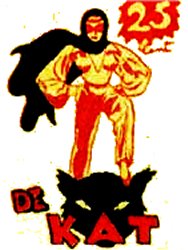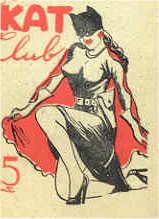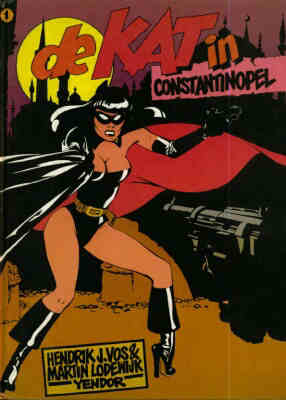 Real Name:
Peggy Day
Real Name:
Peggy Day
de Kat
 Real Name:
Peggy Day
Real Name:
Peggy Day
Identity/Class: Normal human.
Occupation: Actress.
Affiliations: Unidentified boyfriend
Enemies: Count Dracula
Known Relatives: None
Aliases: None
Base of Operations: U.S.A.
 First
Appearance: De Kat "Beeldroman Katserie No. 1" (H.A.T.E., 1948)
First
Appearance: De Kat "Beeldroman Katserie No. 1" (H.A.T.E., 1948)
Powers/Abilities: Deadly martial artist, detective, actress, and burglar. She climbs walls expertly, and has no problem adapting her skills with the katana to win (and survive) a duel on the scimitar. She has lots of connections she can use, both in the day world as actress, and in the shadowy twilight world in which the Cat leaves her trail of dead criminals.
History: Actress Peggy Day maintains a double life. To most people she is a successful actress, but to the criminal world she is the Cat, a globe trotting vigilante who leaves trails of dead criminals in her wake.
Comments: Created by Henk Albers.
De Kat was first published in the late 1940’s as a “beeldroman” (=picture novel, see Dick Bos) as a rather underground kind of thing, like every series in that format. She was not the only masked hero, but she was the only heroine with a series. The inventor of the word “beeldroman” had his own masked powerful hero, de Tweede Pimpernel (the Second Pimpernel) from #6 published by HATE too, added to them the even more exotic Tarzan and the Zwarte Ruiter (The Black Rider, a Western hero); HATE was the publisher in the format for the costumed hero fan to love. In late 1948 comics in general, and the picture novel in particular, suffered the brunt of the Dutch version of the anti-comics crusade, with a governmental anti-comics guide line in late October and a murder in November attributed to picture novels in late December. HATE’s publisher was as shocked as anybody else by that storm of negative reporting and stopped immediately, with a historic publication about the Battle of Arnhem becoming the last HATE publication.
As the only masked heroine of her relatively underground format she was already a very dangerous lady in the 40’s. Her travels seem to include (but not to be limited to) New York, Paris, Amsterdam, a Locksley Hall, Mars (!), Hollywood and Berlin. De Kat is often listed as one of the more “shocking” heroes of the format, which may have been related to the fact that Henk Albers, her creator, writer and artist, had gotten in a bit of trouble with the police over some more or less “risky” mags. The Cat “female, armed, masked and vigilante” may have been rather a culture shock, and thus she disappeared with the other HATE heroes.
 Of course, Tarzan returned to Dutch
comics in hundreds of adventures, and in 1980 the Cat came back too. The
idea was that Martin Lodewijk would be the writer and that every new book
would contain a full adventure drawn by another artist. At one time there
were 5 artists busy with the series, but only two adventures were published,
the first, "De Kat in Constantinopel" with art by Hendrik J.Vos, the second
"De kat in Katendrecht" with art by Bart van Erkel. Both of them were at
least to U.S. standards - definitely no Code material: Drugs, sex, nudity,
porn, prostitution, excessive violence, the whole bunch with the main heroine
being a vigilante killer. The Cat of the 80’s is seen destroying some
corrupt cops in Istanbul and snuff movie producers in Rotterdam (as well
and stealing a lot of money from a human version of the Beagle Boys for charity),
with her profession as actress being the reason for her involvement in.
Production had started on the adventures in Kitzbühel and California,
as well as one that would bring her to the Kurfürstendam in Berlin.
Further announced adventures would have brought her to Caracas, Kalamazoo,
Catalonia, Casablanca, Kansas City, Canton, Cannes, the Kalahari, Canada,
Karatsji, Kazakhstan, Kattendijke, Khabarowsk, the Caucasian mountains, Cape
Town, Kabul, Cairo, the Carpathian mountains, Cadiz, Calcutta, Cameroon,
Kalgoorlie, Cat, Castile, Khartoum, Kampuchea, Karlsruhe, Carcassonne, Canberra,
Karang Koko, Calgary, Calais and the Karakoroum. Hendrik J. Vos recently
(2006) released a new story of de Kat, "De Kat in de Karpaten", finally providing
de Kat's long promised Carpathian encounter with Count Dracula.
Of course, Tarzan returned to Dutch
comics in hundreds of adventures, and in 1980 the Cat came back too. The
idea was that Martin Lodewijk would be the writer and that every new book
would contain a full adventure drawn by another artist. At one time there
were 5 artists busy with the series, but only two adventures were published,
the first, "De Kat in Constantinopel" with art by Hendrik J.Vos, the second
"De kat in Katendrecht" with art by Bart van Erkel. Both of them were at
least to U.S. standards - definitely no Code material: Drugs, sex, nudity,
porn, prostitution, excessive violence, the whole bunch with the main heroine
being a vigilante killer. The Cat of the 80’s is seen destroying some
corrupt cops in Istanbul and snuff movie producers in Rotterdam (as well
and stealing a lot of money from a human version of the Beagle Boys for charity),
with her profession as actress being the reason for her involvement in.
Production had started on the adventures in Kitzbühel and California,
as well as one that would bring her to the Kurfürstendam in Berlin.
Further announced adventures would have brought her to Caracas, Kalamazoo,
Catalonia, Casablanca, Kansas City, Canton, Cannes, the Kalahari, Canada,
Karatsji, Kazakhstan, Kattendijke, Khabarowsk, the Caucasian mountains, Cape
Town, Kabul, Cairo, the Carpathian mountains, Cadiz, Calcutta, Cameroon,
Kalgoorlie, Cat, Castile, Khartoum, Kampuchea, Karlsruhe, Carcassonne, Canberra,
Karang Koko, Calgary, Calais and the Karakoroum. Hendrik J. Vos recently
(2006) released a new story of de Kat, "De Kat in de Karpaten", finally providing
de Kat's long promised Carpathian encounter with Count Dracula.
The series was not a huge success, but the Rotterdam adventure (drawn by Bart van Erkel) was published as two comics in English by Aircel Publications as "The Cat". The color scheme on the cover of the Aircel publication is different from the one used in the Netherlands for the cover of the Istanbul adventure and the 1-page "Beagle Boys" adventure (The Beagle Boys had a different name and were fully human, but were a recognisable parody of the Disney characters nonetheless. The art of the cover of the second comic looks apart from the coloring, very much like the cover of the Istanbul adventure.
The one page adventure was just very simply a reference to itself, explaining why the Cat steals from criminals: for charity, which is a nice play with levels of meaning in a story in a collection of comic stories sold for a charity, in this case Mozambique. Except for being the latest (1987), this story is mostly interesting here as it shows the Cat recognized as a superheroine, but the question mark about her behaviour remains in place.
Large portions of this profile by Theodoor Westerhof
CLARIFICATIONS: Not to be confused with
Kat, partner of Max Steel
Cat, Haunted
Cat, Canadian
Cat, Bunty
Cat, partner of Mouse
Cat, member of the GeneDogs
The Cat, Australian hero
Cat-Girl, 40s
Cat Girl, from Sally
Cat-Man, Golden Age hero
Cat-Man, Australian
Catman, Canadian hero
Catman, Hong Kong hero
Catwoman, DC character
The Cat, original name for Marvel's Tigra
Any Additions/Corrections? Please let me know.
All images and characters depicted on this site are copyright their respective holders, and are used for informational purposes only. No infringement is intended and copyrights remain at source.